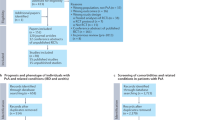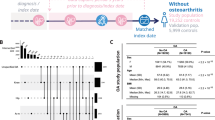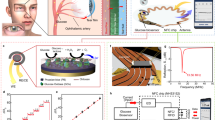Abstract
Objective
To evaluate the sensitivity and specificity of the ABCD progression display for keratoconus progression.
Methods
Data was collected from patients that underwent at least two Pentacam assessments 6 months apart. Sensitivity and specificity were calculated for the ABCD progression display. Progression was defined by criterion 1: change in two ABCD parameters above 80% confidence interval (CI) or criterion 2: change in one ABCD parameter above 95%CI. Receiver operating characteristic analysis compared the area under the curve (AUC) of all ABCD parameter combinations.
Results
Thirty eyes were evaluated over a median time of 10.3 months. Progression by criterion 1 resulted in a sensitivity of 61.9% and specificity of 88.9%. Progression by criterion 2 resulted in higher sensitivity (80.9%) and specificity (100%). Pairwise comparisons of the ROC curves show that the AUC achieved by criterion 2 was significantly higher than criterion 1 (0.905 vs. 0.754, p = 0.0332). Evaluation of all ABCD combinations with a significant change of 80% or 95% CI did not show superiority over criterion 1 or 2 regarding progression detection. The D parameter had a very low AUC (0.5–0.556).
Conclusions
The ABCD progression display can assess keratoconus progression with high sensitivity and specificity, thus assisting the patients’ decision-making process. The D parameter did not contribute to the sensitivity or specificity of this classification.
This is a preview of subscription content, access via your institution
Access options
Subscribe to this journal
Receive 18 print issues and online access
$259.00 per year
only $14.39 per issue
Buy this article
- Purchase on Springer Link
- Instant access to full article PDF
Prices may be subject to local taxes which are calculated during checkout

Similar content being viewed by others
Data availability
The datasets generated during and/or analyzed during the current study are not publicly available due to containing information that could compromise patient privacy but are available from the corresponding author on reasonable request.
References
Ferdi AC, Nguyen V, Gore DM, Allan BD, Rozema JJ, Watson SL. Keratoconus natural progression: a systematic review and meta-analysis of 11529 eyes. Ophthalmology. 2019;126:935–45. https://doi.org/10.1016/j.ophtha.2019.02.029.
Nicula C, Pop R, Rednik A, Nicula D. 10-year results of standard cross-linking in patients with progressive keratoconus in Romania. J Ophthalmol. 2019;2019:8285649. https://doi.org/10.1155/2019/8285649.
Lavric A, Valentin P. KeratoDetect: keratoconus detection algorithm using convolutional neural networks. Comput Intell Neurosci. 2019;2019:8162567. https://doi.org/10.1155/2019/8162567.
Ruiz Hidalgo I, Rodriguez P, Rozema JJ, Ní Dhubhghaill S, Zakaria N, Tassignon M-J, et al. Evaluation of a machine-learning classifier for keratoconus detection based on scheimpflug tomography. Cornea. 2016;35:827–32. https://doi.org/10.1097/ICO.0000000000000834.
Duncan JK, Belin MW, Borgstrom M. Assessing progression of keratoconus: novel tomographic determinants. Eye Vis Lond Engl. 2016;3:6. https://doi.org/10.1186/s40662-016-0038-6.
Martínez-Abad A, Piñero DP. New perspectives on the detection and progression of keratoconus. J Cataract Refract Surg. 2017;43:1213–27. https://doi.org/10.1016/j.jcrs.2017.07.021.
Shajari M, Steinwender G, Herrmann K, Kubiak KB, Pavlovic I, Plawetzki E, et al. Evaluation of keratoconus progression. Br J Ophthalmol. 2019;103:551–7. https://doi.org/10.1136/bjophthalmol-2017-311651.
Wisse RPL, Simons RWP, van der Vossen MJB, Muijzer MB, Soeters N, Nuijts RMMA, et al. Clinical evaluation and validation of the Dutch crosslinking for keratoconus score. JAMA Ophthalmol. 2019;137:610–6. https://doi.org/10.1001/jamaophthalmol.2019.0415.
Belin MW, Meyer JJ, Duncan JK, Gelman R, Borgstrom M. Assessing progression of keratoconus and cross-linking efficacy: the Belin ABCD progression display. Int J Keratoconus Ectatic Corneal Dis. 2017;6:1–10. https://doi.org/10.5005/jp-journals-10025-1135.
Hatch W, El-Defrawy S, Ong Tone S, Stein R, Slomovic AR, Rootman DS, et al. Accelerated corneal cross-linking: efficacy, risk of progression, and characteristics affecting outcomes. a large, single-center prospective study. Am J Ophthalmol. 2020;213:76–87. https://doi.org/10.1016/j.ajo.2020.01.006.
Karakosta A, Vassilaki M, Plainis S, Elfadl NH, Tsilimbaris M, Moschandreas J. Choice of analytic approach for eye-specific outcomes: one eye or two. Am J Ophthalmol. 2012;153:571–9.e1. https://doi.org/10.1016/j.ajo.2011.08.032.
Belin MW, Alizadeh R, Torres-Netto EA, Hafezi F, Ambrósio R, Pajic B. Determining progression in ectatic corneal disease. Asia-Pac J Ophthalmol Philos. 2020;9:541–8. https://doi.org/10.1097/APO.0000000000000333.
Hajian-Tilaki KO, Hanley JA. Comparison of three methods for estimating the standard error of the area under the curve in ROC analysis of quantitative data. Acad Radiol. 2002;9:1278–85.
Flockerzi E, Xanthopoulou K, Goebels SC, Zemova E, Razafimino S, Hamon L, et al. Keratoconus staging by decades: a baseline ABCD classification of 1000 patients in the Homburg Keratoconus Center. Br J Ophthalmol. 2020. https://doi.org/10.1136/bjophthalmol-2020-316789.
Balparda K, Herrera-Chalarca T, Silva-Quintero LA, Torres-Soto SA, Segura-Muñoz L, Vanegas-Ramirez CM. Both subjective emotional distress and visual handicap correlate with Belin ABCD classification in the worse eye as measured with the “Keratoconus End-Points Assessment Questionnaire” (KEPAQ). Clin Ophthalmol. 2020;14:1839–45. https://doi.org/10.2147/OPTH.S261785.
Ding L, Wang J, Niu L, Shi W, Qian Y. Pentacam Scheimpflug tomography findings in Chinese patients with different corneal diameters. J Refract Surg. 2020;36:688–95. https://doi.org/10.3928/1081597X-20200730-02.
Imbornoni LM, Wise RE, Taravella MJ, Hickey F, McCourt EA. Keratoconus and corneal morphology in patients with Down syndrome at a pediatric hospital. J AAPOS. 2020;24:140.e1–5. https://doi.org/10.1016/j.jaapos.2020.02.004.
Zhang M, Zhang F, Li Y, Song Y, Wang Z. Early diagnosis of keratoconus in Chinese myopic eyes by combining corvis ST with pentacam. Curr Eye Res. 2020;45:118–23. https://doi.org/10.1080/02713683.2019.1658787.
Grisevic S, Gilevska F, Biscevic A, Ahmedbegovic-Pjano M, Bohac M, Pidro A. Keratoconus progression classification one year after performed crosslinking method based on ABCD keratoconus grading system. Acta Inform Med. 2020;28:18–23. https://doi.org/10.5455/aim.2020.28.18-23.
Ali Yekta A, Reza Sedaghat M, Momeni‐Moghaddam H, Danesh Z, Khabazkhoob M, Heravian Shandiz J, et al. Changes in the ABCD keratoconus grade after corneal cross linking. Acta Ophthalmol. 2019;97:j.1755-3768.2019.5037A. https://doi.org/10.1111/j.1755-3768.2019.5037A.
Sağlık A. Progression analysis with ABCD grading system following corneal collagen cross-linking in keratoconus. Beyoglu Eye J. 2019. https://doi.org/10.14744/bej.2019.49469.
Vinciguerra R, Belin MW, Borgia A, Piscopo R, Montericcio A, Confalonieri F, et al. Evaluating keratoconus progression prior to crosslinking: Kmax versus the ABCD grading system. J Cataract Refract Surg. 2020. https://doi.org/10.1097/j.jcrs.0000000000000475.
Dubinsky-Pertzov B, Reinhardt O, Gazit I, Or L, Hecht I, Pras E, et al. The ABCD keratoconus grading system—a useful tool to estimate keratoconus progression in the pediatric population. Cornea. 2020. https://doi.org/10.1097/ICO.0000000000002632.
Neuhann S, Schuh A, Krause D, Liegl R, Schmelter V, Kreutzer T, et al. Comparison of variables measured with a Scheimpflug device for evaluation of progression and detection of keratoconus. Sci Rep. 2020;10:19308. https://doi.org/10.1038/s41598-020-76020-6.
Cunha AM, Correia PJ, Alves H, Torrão L, Moreira R, Falcão-Reis F, et al. Keratoconus enlargement as a predictor of keratoconus progression. Sci Rep. 2021;11:21079. https://doi.org/10.1038/s41598-021-00649-0.
Jiménez-García M, Kreps EO, Ní Dhubhghaill S, Koppen C, Rozema JJ, The REDCAKE Study Group. Determining the most suitable tomography-based parameters to describe progression in keratoconus. The retrospective digital computer analysis of keratoconus evolution project. Eye Contact Lens Sci Clin Pract. 2021;47:486–93. https://doi.org/10.1097/ICL.0000000000000800.
Erol MA, Atalay E, Özalp O, Divarcı A, Yıldırım N. Superiority of baseline biomechanical properties over corneal tomography in predicting keratoconus progression. Turk J Ophthalmol. 2021;51:257–64. https://doi.org/10.4274/tjo.galenos.2020.78949.
Danesh Z, Sedaghat M-R, Momeni-Moghaddam H, Yekta A-A, Belin MW. Corneal stability and visual acuity 1 year after corneal cross-linking assessed using the ABCD keratoconus staging system. J Refract Surg. 2021;37:700–6. https://doi.org/10.3928/1081597X-20210712-09.
Gustafsson I, Faxén T, Vicente A, Bergström A, Ivarsen A, Hjortdal JØ. An inter-day assessment of the ABC parameters in the evaluation of progressive keratoconus. Sci Rep. 2021;11:16037. https://doi.org/10.1038/s41598-021-95503-8.
Kosekahya P, Caglayan M, Koc M, Kiziltoprak H, Tekin K, Atilgan CU. Longitudinal evaluation of the progression of keratoconus using a novel progression display. Eye Contact Lens. 2019;45:324–30. https://doi.org/10.1097/ICL.0000000000000582.
Author information
Authors and Affiliations
Contributions
AA collected data, conducted the statistical analysis, and wrote the draft of the article. RY collected data, updated reference lists and reviewed the paper. AT validated the statistical analysis. UE, YN, EL, and IB interpreted the results and reviewed the paper.
Corresponding author
Ethics declarations
Competing interests
The authors declare no competing interests.
Additional information
Publisher’s note Springer Nature remains neutral with regard to jurisdictional claims in published maps and institutional affiliations.
Supplementary information
Rights and permissions
About this article
Cite this article
Achiron, A., Yavnieli, R., Tiosano, A. et al. ABCD progression display for keratoconus progression: a sensitivity-specificity study. Eye 37, 1566–1570 (2023). https://doi.org/10.1038/s41433-022-02183-3
Received:
Revised:
Accepted:
Published:
Issue Date:
DOI: https://doi.org/10.1038/s41433-022-02183-3



